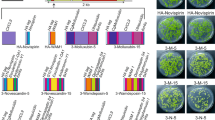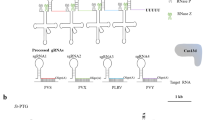Abstract
Here we describe a strategy for engineering transgenic plants with broad-spectrum resistance to bacterial and fungal phytopathogens. We expressed a synthetic gene encoding a N terminus-modified, cecropin–melittin cationic peptide chimera (MsrA1), with broad-spectrum antimicrobial activity. The synthetic gene was introduced into two potato (Solanum tuberosum L.) cultivars, Desiree and Russet Burbank, stable incorporation was confirmed by PCR and DNA sequencing, and expression confirmed by reverse transcription (RT)-PCR and recovery of the biologically active peptide. The morphology and yield of transgenic Desiree plants and tubers was unaffected. Highly stringent challenges with bacterial or fungal phytopathogens demonstrated powerful resistance. Tubers retained their resistance to infectious challenge for more than a year, and did not appear to be harmful when fed to mice. Expression of msrA1 in the cultivar Russet Burbank caused a striking lesion-mimic phenotype during leaf and tuber development, indicating its utility may be cultivar specific. Given the ubiquity of antimicrobial cationic peptides as well as their inherent capacity for recombinant and combinatorial variants, this approach may potentially be used to engineer a range of disease-resistant plants.
This is a preview of subscription content, access via your institution
Access options
Subscribe to this journal
Receive 12 print issues and online access
$209.00 per year
only $17.42 per issue
Buy this article
- Purchase on Springer Link
- Instant access to full article PDF
Prices may be subject to local taxes which are calculated during checkout






Similar content being viewed by others
References
Baker, B., Zambryski, P., Staskawicz, B. & Dinesh-Kumar, S.P. Signaling in plant–microbe interactions. Science 267, 726–733 (1997).
Mourgues, F., Brisset, M-N. & Chevreau, E. Strategies to improve plant resistance to bacterial diseases through genetic engineering. Trends Biotechnol. 16, 203–210 (1998).
Hancock, R.E.W. & Lehrer, R. Cationic peptides: a new source of antibiotics. Trends Biotechnol. 16, 82–88 (1998).
Cao, H., Li, X. & Dong, X. Generation of broad-spectrum disease resistance by overexpression of an essential regulatory gene in systemic acquired resistance. Proc. Natl. Acad. Sci. USA 95, 6531–6536 (1999).
Heo, W.D. et al. Involvement of specific calmodulin isoforms in salicylic acid-independent activation of plant disease resistance responses. Proc. Natl. Acad. Sci. USA 96, 766–771 (1999).
Hancock, R.E.W., Falla, T. & Brown, M. Cationic bactericidal peptides. Adv. Microbiol. Physiol. 37, 135–175 (1995).
Nicholas, P. & Mor, A. Peptides as weapons against microorganisms in the chemical defense system of vertebrates. Annu. Rev. Microbiol. 49, 277–304 (1995).
Zasloff, M. Antibiotic peptides as mediators of innate immunity. Curr. Opin. Immunol. 4, 3–7 (1992).
Cociancich, S. et al. Novel inducible antibacterial peptides from a hemipteran insect, the sap-sucking bug Pyrrhocoris apterus. Biochem. J. 300, 567–575 (1994).
Piers, K.L. & Hancock, R.E.W. The interaction of a recombinant cecropin/melittin hybrid peptide with the outer membrane of Pseudomonas aeruginosa. Mol. Microbiol. 12, 951–958 (1994).
Jaynes, J.M. et al. Expression of a cecropin B lytic peptide analog in transgenic tobacco confers enhanced resistance to bacterial wilt caused by Pseudomonas solanacearum. Plant Sci. 89, 43–53 (1993).
Mitra, A. & Zhang, Z. Expression of human lactoferrin cDNA in tobacco cells produces antibacterial protein(s). Plant Physiol. 106, 977–981 (1994).
Florack, D.E.A, Dirkse, W.G., Visser, B., Heidekamp, F. & Stiekema, W. Expression of biologically active hordothionin in tobacco. Effects of pre- and prosequences at the amino and carboxyl termini of the hordothionin precursor on mature protein expression and sorting. Plant Mol. Biol. 24, 83–96 (1994).
Carmona, M.J., Molina, A., Fernandez, J.A., Lopez-Fando, J.J. & Garcia-Olmedo, F. Expression of the alpha-thionin from barley in tobacco confers enhanced resistance to bacterial pathogens. Plant J. 3, 457–462 (1993).
Allefs, S.J.H.M., De Jong, E.R., Florack, D.E.A., Hoogendoorn, C. & Stiekema, W.J. Erwinia soft rot resistance of potato cultivars expressing antimicrobial peptide tachyplesin I. Molecular Breeding 2, 97–105 (1996).
Allefs, S.J.H.M., Florack, D.E.A., Hoogendoorn, C. & Stiekema W.J. Erwinia soft rot resistance of potato cultivars transformed with a gene construct coding for antimicrobial peptide cecropin B is not altered. Potato J. 72, 437–445 (1995).
Florack, D.E.A. et al. Expression of giant silkmoth cecropin B genes in tobacco. Transgenic Res. 4, 132–141 (1995).
During, K. Genetic engineering for resistance to bacteria in transgenic plants by introduction of foreign genes. Molecular Breeding 2, 297–305 (1996).
Epple, P., Apel, K. & Bohlmann, H. Overexpression of an endogenous thionin enhances resistance of Arabidopsis against Fusarium oxysporum. Plant Cell 9, 509–520 (1997).
Bohman, H.G. & Hultmark, D. Cell-free immunity in insects. Annu. Rev. Microbiol. 41, 103–126 (1987).
van Hofsten, P. et al. Molecular cloning, cDNA sequencing, and chemical synthesis of cecropin B from Hyalophora cecropia. Proc.Natl. Acad. Sci. USA 82, 2240–2243 (1985).
Hultmark, D., Engstrom, A., Bennich, H., Kapur, R. & Boman, H.G. Insect immunity: isolation and structure of cecropin D and four minor antimicrobial components from cecropia pupae. Eur. J. Biochem. 127, 207–217 (1982).
Jaynes, J.M., Xanthopoulos, K.G., Destefano-Beltran, L. & Dodds, J.H. Increasing bacterial disease resistance utilizing antibacterial genes from insects. BioEssays 6, 263–270 (1987).
Nordeen, R.G., Sinden, S.L., Jaynes, J.M. & Owens, L.D. Activity of cecropin SB 37 against protoplast from several plant species and their bacterial pathogens. Plant Sci. 82, 101–107 (1992).
Habermann, E. Bee and wasp venoms. Science 177, 314–322 (1972).
Tosteson, M.T., Holmes, S.J., Razin, M. & Tosteson, D.C. Melittin lysis of red cells. J. Membr. Biol. 87, 35–44 (1985).
Hancock, R.E.W., Brown, M.H. & Piers, K. Cationic peptides and method of preparation. US Patent application serial No. 07/913, 492, filed August 21, 1992.
Datla, R.S.S. et al. Improved high-level constitutive foreign gene expression in plants using an AMV RNA4 untranslated leader sequence. Plant Sci. 94, 139–149 (1993).
Ross, H. Potato breeding—problems and perspectives: advances in plant breeding. J. Plant Breeding (Supp.) 13, 132 (1986).
Cavallarin L., Andreu, D. & San Segundo, B. Cecropin A-derived peptides are potent inhibitors of fungal pathogens. Mol. Plant Microbe Interact. 11, 218–227 (1998).
Powell, W.A., Catranis, C.M. & Maynard, C.A. Synthetic antimicrobial peptide design. Mol. Plant Microbe Interact. 8, 792–794 (1995).
Mittler, R., Shulaev, V. & Lam, E. Coordinated activation of programmed cell death and defense mechanisms in transgenic tobacco plants expressing a bacterial proton pump. Plant Cell 7, 29–42 (1995).
Dangl, J.L., Dietrich, R.A. & Richberg, M.H. Death don't have no mercy: cell death programs in plant–microbe interactions. Plant Cell 8, 1793–1807 (1996).
Mittler, R. & Lam, E. Sacrifice in the face of foes: pathogen-induced programmed cell death in plants. Trends Microbiol. 4, 10–15 (1996).
Abad, M.S. et al. Characterization of acquired resistance in lesion-mimic transgenic potato expressing bacterio-opsin. Mol. Plant Microbe Interact. 10, 635–645 (1997).
Dempsey, D.A., Silva, H. & Klessig, D.F. Engineering disease and pest resistance in plants. Trends Microbiol. 6, 54–61 (1997).
Sambrook, J., Fritsch, E.F. & Maniatis, T. Molecular cloning: a laboratory manual, Edn. 2. (Cold Spring Harbor Laboratory Press, Cold Spring Harbor, NY; 1989).
Holsters, M. et al. Transfection and transformation of A. tumefaciens. Mol. Gen. Genet. 163, 181–187 (1978).
De Block, M. Genotype-independent leaf disc transformation of potato (Solanum tuberosum) using Agrobacterium tumefaciens. Theor. Appl. Genet. 76, 767–774 (1988).
Wagner, D.B. et al. Chloroplast DNA polymorphisms in lodgepole and jack pines and their hybrids. Proc. Natl. Acad. Sci. USA 84, 2097–2100 (1987).
Verwoerd, T.C., Dekker, B.M.M. & Hoekema, A. A small-scale procedure for the rapid isolation of plant RNAs. Nucleic Acids Res. 17, 2362 (1989).
Schägger, H. & von Jagow, G. Tricine–sodium dodecyl sulphate–polyacrylamide gelelectrophoresis for the separation of proteins in the range from 1 to 100 kDa. Anal. Biochem. 166, 368–379 (1987).
Friedrich, C., Scott, M., Karunaratne, N., Yan, H. & Hancock, R.E.W. NaCl resistant α-helical cationic antimicrobial peptides. Antimicrob. Agents Chemother. 43, 1542–1548 (1999).
Acknowledgements
This work was funded by the Natural Sciences and Engineering Research Council (NSERC) Strategic grant to S.M. and W.W.K. We thank N. Vettakorrumkankav, L. Sun, X. Yu, and T. Stevenson for expert technical assistance, and Dr. Zamir Punja (Simon Fraser University, Burnaby, BC, Canada) for providing fungal phytopathogens.
Author information
Authors and Affiliations
Corresponding authors
Rights and permissions
About this article
Cite this article
Osusky, M., Zhou, G., Osuska, L. et al. Transgenic plants expressing cationic peptide chimeras exhibit broad-spectrum resistance to phytopathogens. Nat Biotechnol 18, 1162–1166 (2000). https://doi.org/10.1038/81145
Received:
Accepted:
Issue Date:
DOI: https://doi.org/10.1038/81145
This article is cited by
-
Effects of adding poly-histidine tag on stability, antimicrobial activity and safety of recombinant buforin I expressed in periplasmic space of Escherichia coli
Scientific Reports (2023)
-
Lactoferrin and its role in biotechnological strategies for plant defense against pathogens
Transgenic Research (2023)
-
Turning Waste into Beneficial Resource: Implication of Ageratum conyzoides L. in Sustainable Agriculture, Environment and Biopharma Sectors
Molecular Biotechnology (2022)
-
Features and applications of Ent35-MccV hybrid bacteriocin: current state and perspectives
Applied Microbiology and Biotechnology (2020)



